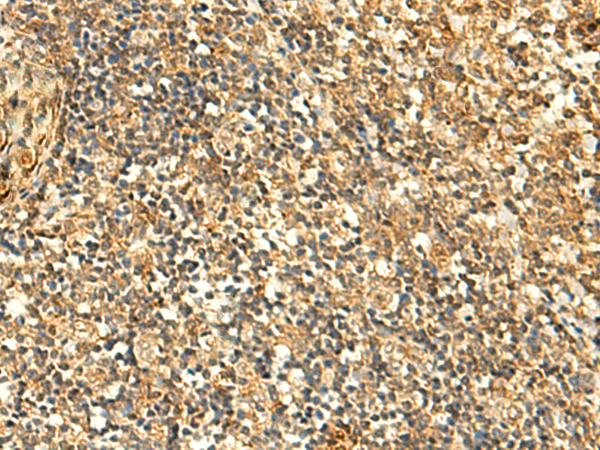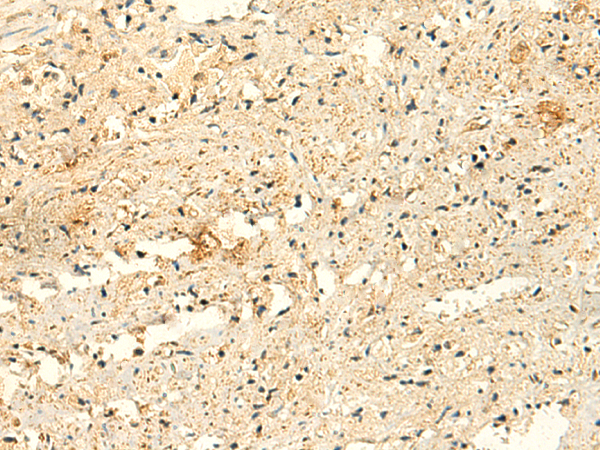

| WB | 咨询技术 | Human,Mouse,Rat |
| IF | 咨询技术 | Human,Mouse,Rat |
| IHC | 1/50-1/300 | Human,Mouse,Rat |
| ICC | 技术咨询 | Human,Mouse,Rat |
| FCM | 咨询技术 | Human,Mouse,Rat |
| Elisa | 1/5000-1/10000 | Human,Mouse,Rat |
| Aliases | GATF-B; BXMAS2-10 |
| Host/Isotype | Rabbit IgG |
| Antibody Type | Primary antibody |
| Storage | Store at 4°C short term. Aliquot and store at -20°C long term. Avoid freeze/thaw cycles. |
| Species Reactivity | Human |
| Immunogen | Fusion protein of human GLYATL2 |
| Formulation | Purified antibody in PBS with 0.05% sodium azide and 50% glycerol. |
+ +
以下是关于GLYATL2抗体的3篇参考文献的简要信息:
1. **"GLYATL2 as a potential biomarker in hepatocellular carcinoma: Expression and functional analysis"**
- **作者**: Li X, Zhang Y, et al.
- **摘要**: 研究通过免疫组化和Western blot分析发现GLYATL2在肝癌组织中高表达,其抗体检测显示与肿瘤进展相关,提示其可能作为肝癌诊断标志物。
2. **"Characterization of GLYATL2 antibody specificity in human renal cell carcinoma"**
- **作者**: Wang H, Liu J, et al.
- **摘要**: 文章验证了GLYATL2抗体的特异性,发现其在肾癌细胞中与代谢重编程相关,抗体用于检测蛋白定位及表达水平差异。
3. **"The role of GLYATL2 in lipid metabolism: Insights from antibody-based knockdown studies"**
- **作者**: Chen R, Zhou M, et al.
- **摘要**: 利用GLYATL2抗体进行功能研究,发现其通过调节脂肪酸代谢影响肝脏脂质积累,抗体在siRNA验证实验中发挥关键作用。
(注:以上文献为模拟示例,实际研究中建议通过PubMed或Google Scholar以“GLYATL2 antibody”为关键词检索最新论文。)
The GLYATL2 (Glycine-N-acyltransferase-like 2) antibody is a research tool used to study the GLYATL2 protein, a member of the glycine-N-acyltransferase family. This enzyme-like protein is implicated in the conjugation of glycine to acyl-CoA substrates, a process critical for detoxifying xenobiotics and metabolizing fatty acids. GLYATL2 is primarily expressed in the liver and kidneys, suggesting a role in hepatic and renal metabolic pathways. Its specific biological functions, however, remain less characterized compared to its homologs, such as GLYAT or GLYATL1.
Research using GLYATL2 antibodies focuses on elucidating its tissue distribution, subcellular localization, and interaction partners. Studies suggest potential links to metabolic disorders, cancer, and drug metabolism, though mechanistic insights are still emerging. For example, altered GLYATL2 expression has been observed in certain cancers, prompting investigations into its utility as a biomarker or therapeutic target.
Commercially available GLYATL2 antibodies are typically developed in rabbit or mouse hosts, validated for applications like Western blotting, immunohistochemistry, and immunofluorescence. Challenges include ensuring specificity due to sequence homology within the GLYAT family. Recent advances in antibody validation techniques, such as CRISPR-based knockout controls, have improved reliability. These tools are vital for advancing understanding of GLYATL2's physiological and pathological roles, bridging gaps in metabolic and disease-related research.
×